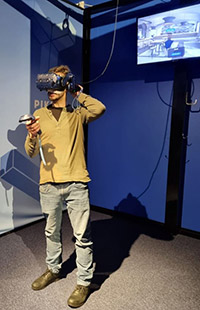
This website offers you results, experiences and recommendations created in piloting the use of Virtual Reality, or VR, in vocational education and training.
The results have been put together by a group of teachers of English language, Math and Electricity, together with project managers and a group of experienced staff members both of internationalization as well as of the use of new technology in teaching and learning. We are from 5 countries: Finland, Denmark, the Netherlands, Italy and Spain.
The main results are to be found in the Results -section. Before anything else, please read the recommendations! It is essential to be aware of what to consider when starting to use VR for the first time. Then see the Tutorials 1 and 2 to learn how to get started, and continue by visiting “VROOM” – our very own VR-platform in SPATIAL! Visiting is free, and you will be able to take your first steps and learn how things work!
If you are interested to experiment some teaching and learning in VROOM, please read the VROOM user policy -document to go ahead.
Finally, we also share best practices of blended learning, deriving from the time when covid hit us and contact lessons where forbidden. Partners schools created and tried out many useful ways to teach and to share with colleagues. A sample of Best Practices are shared in the Results section as well.
In the links -section we have collected links e.g. to the equipment we have tested out.
Virtual reality is still a rather new didactic approach for vocational education and training. It does make learning fun for the learners; this we have witnessed over and over again. VR allows practicing e.g. difficult customer situation easier than in real life. It allows students to make experiences and to meet and interact with students from other countries without ever having to leave the classroom. Imagine students visiting schools, lessons, laboratories, workshops, companies located in other countries whilst sitting at their desks.
Benefits of the application of VR within teaching and learning can be summarized as follows:
- VR in education can replace textbooks with interactive educational experiences
- VR promotes Peer to Peer -interaction since students are encouraged to interact with each other
- VR motivates and engages students: the modern technologies attract students’ attention and promote their active involvement – they get the feeling of really having met the persons they interact with
- VR is inclusive: every student gets the same opportunity to enjoy the experience, it has potential to involve a wide range of students, such as students with special needs
- VR promotes imagination and creative thinking since the students will be transported out of their classroom.
Welcome to read more in the Results- section, and visit VROOM – experience it for yourself!